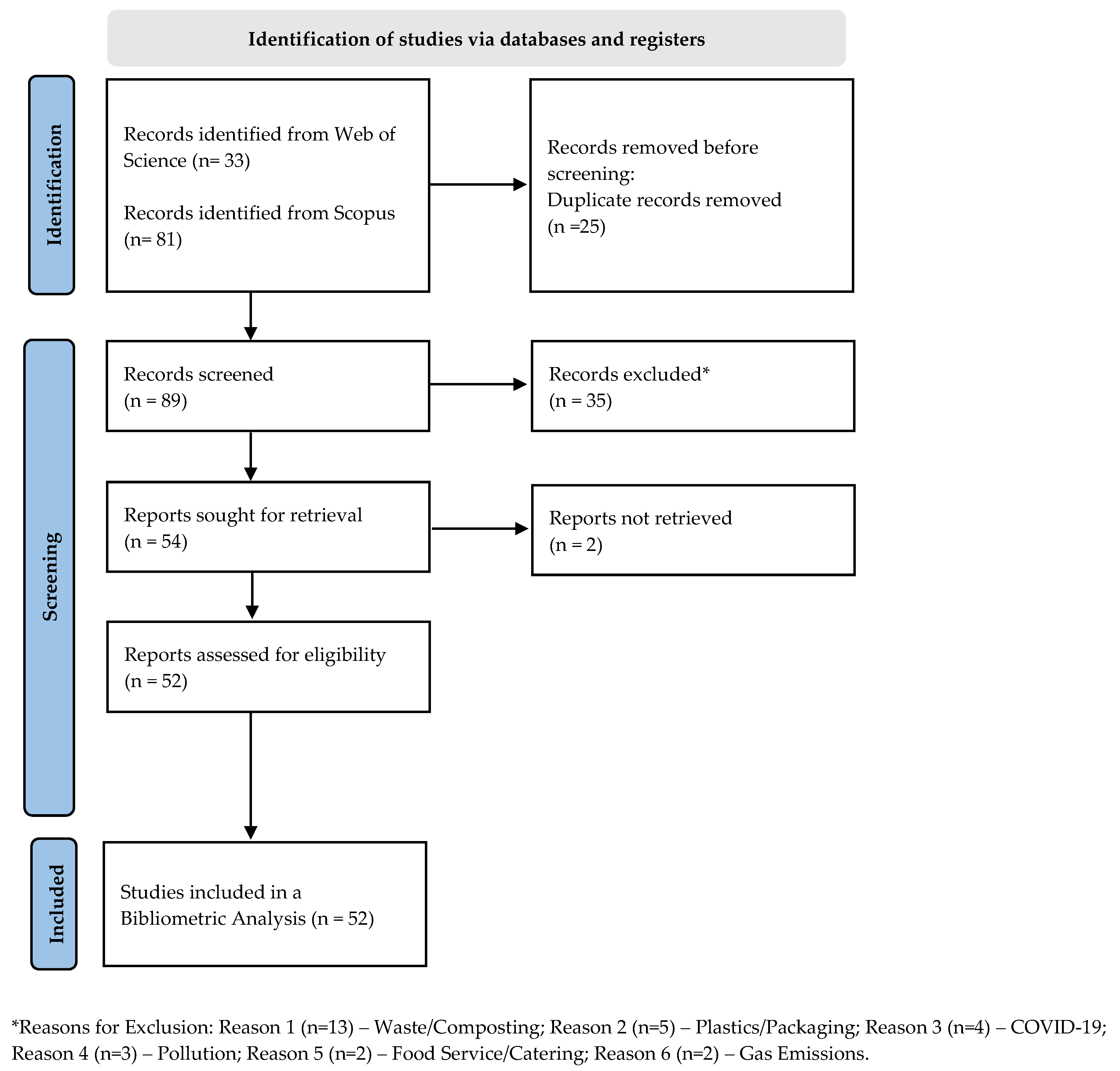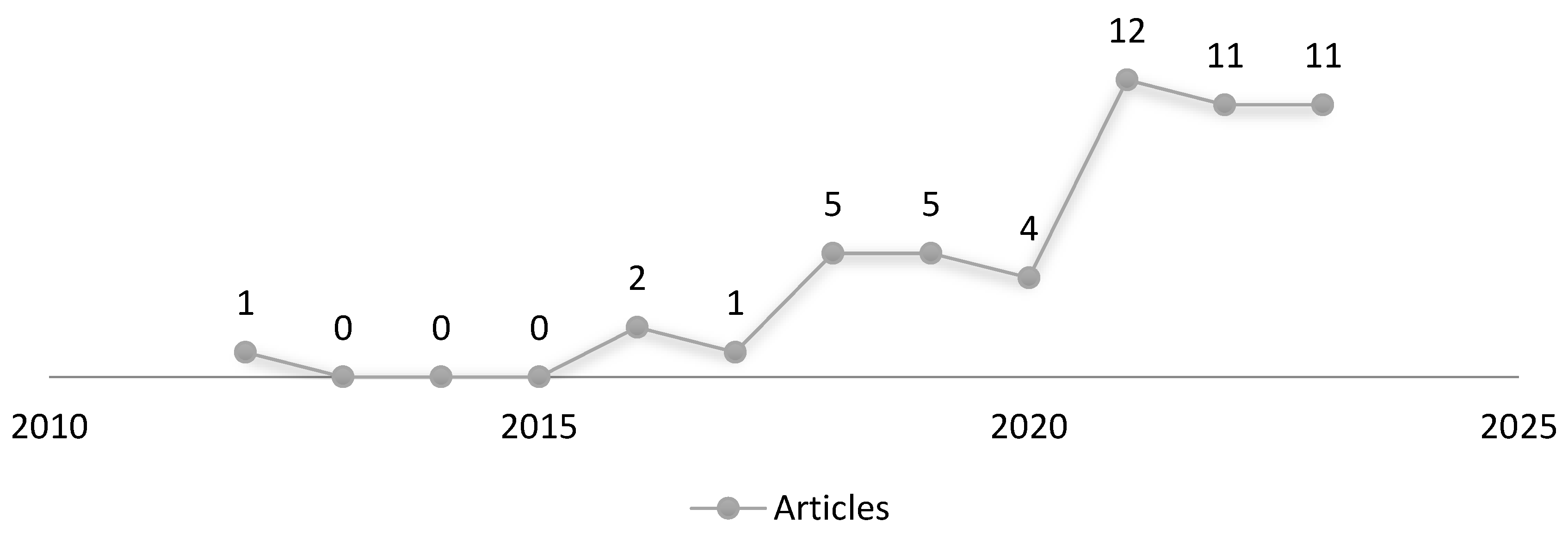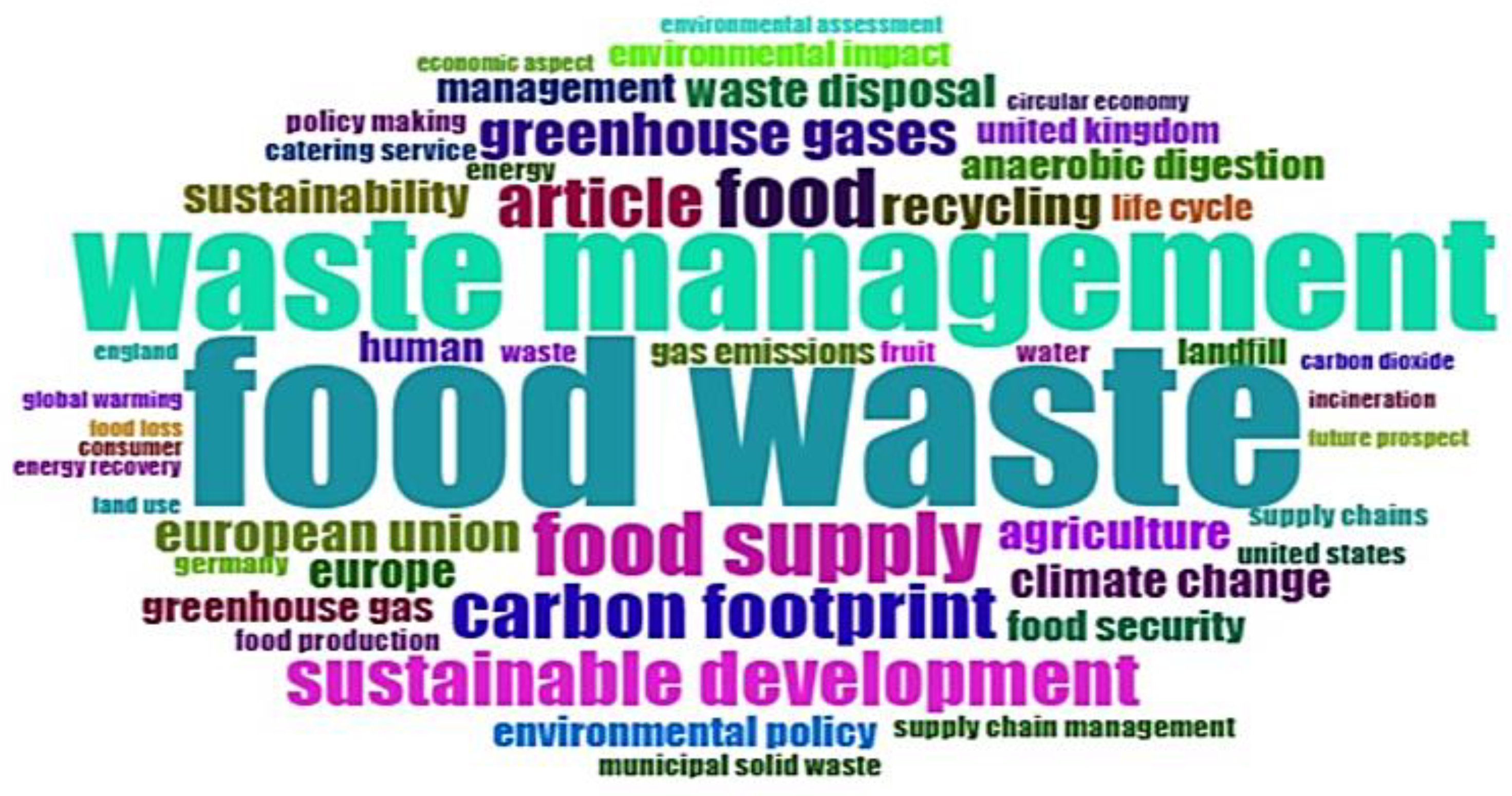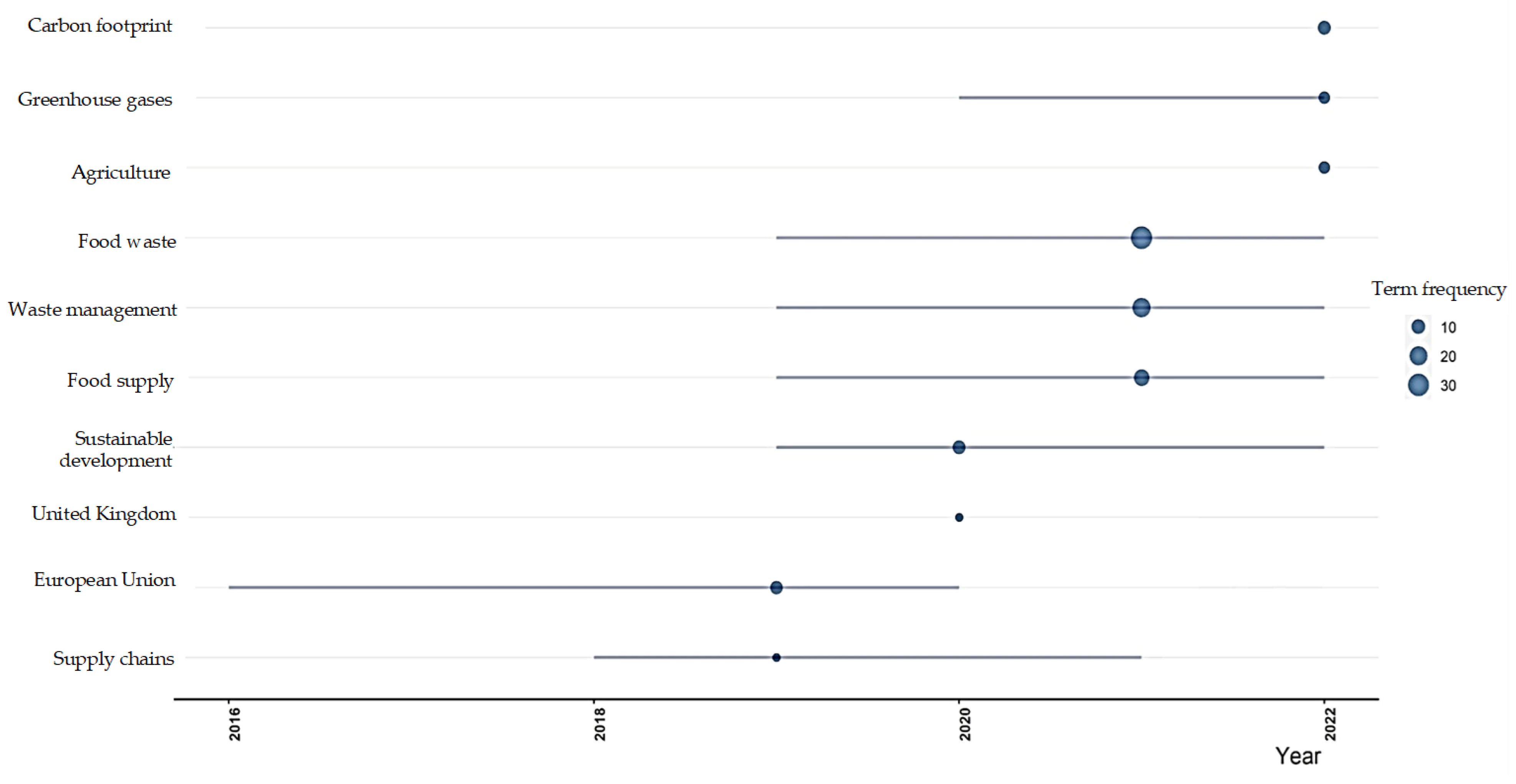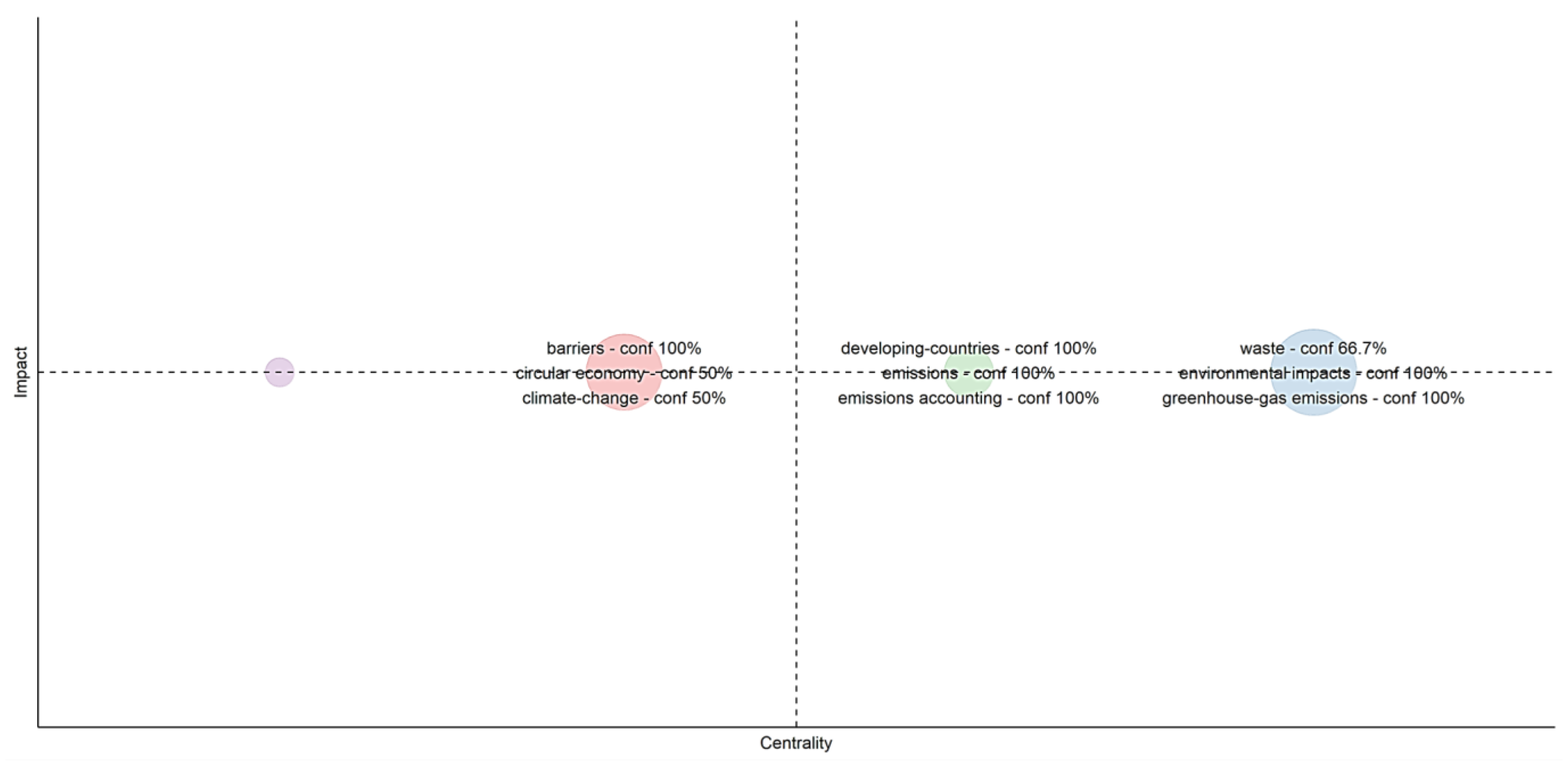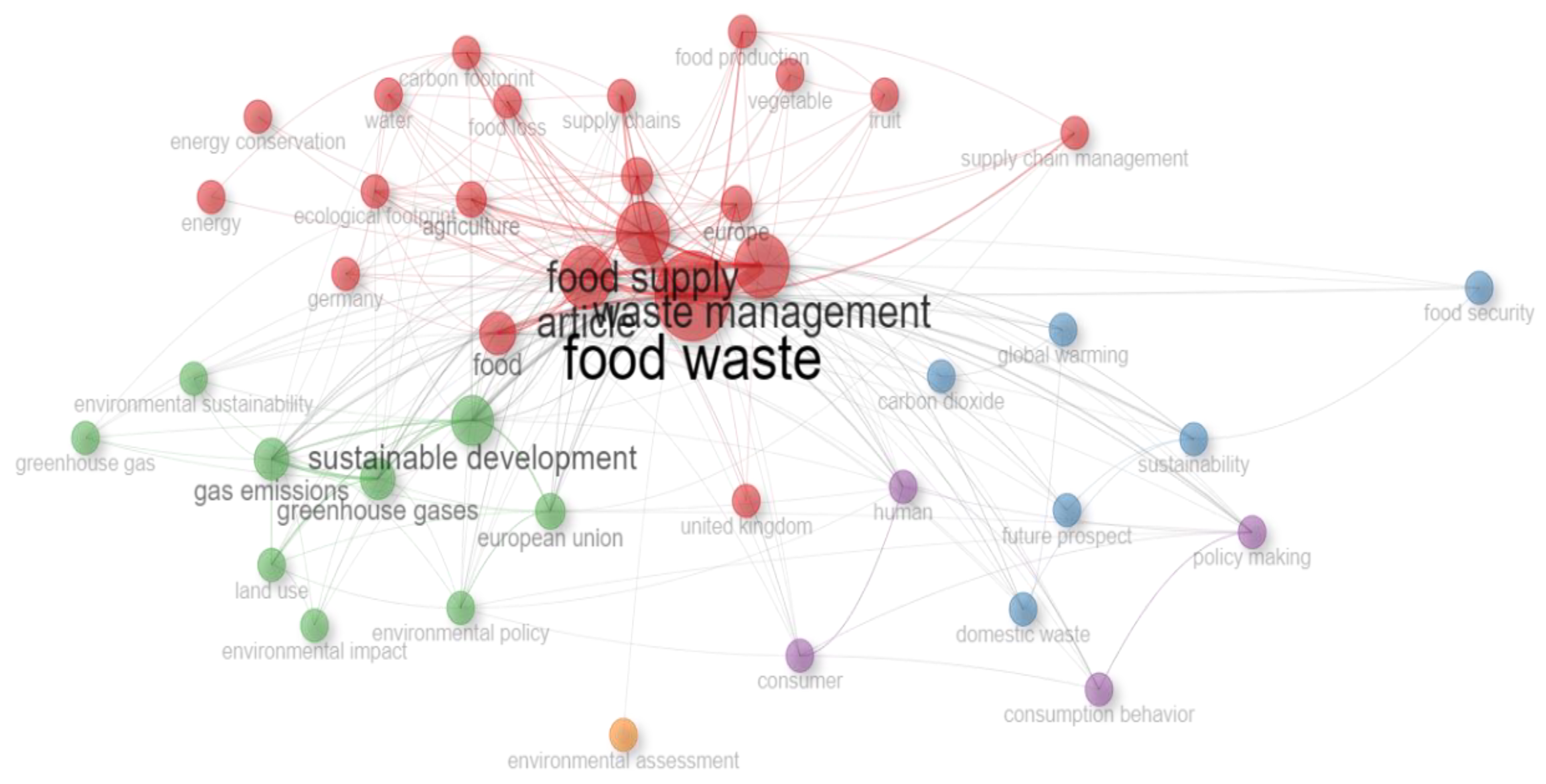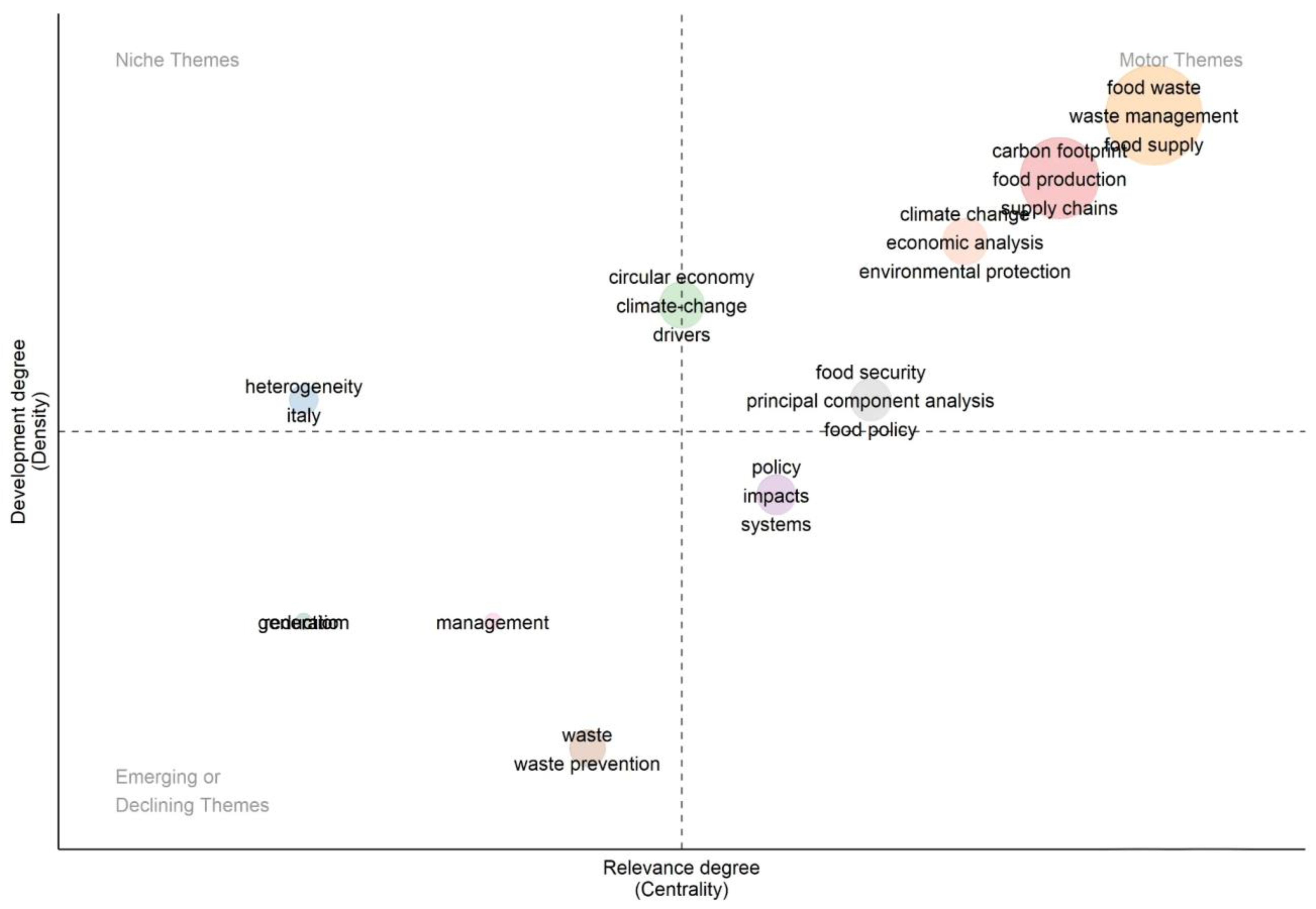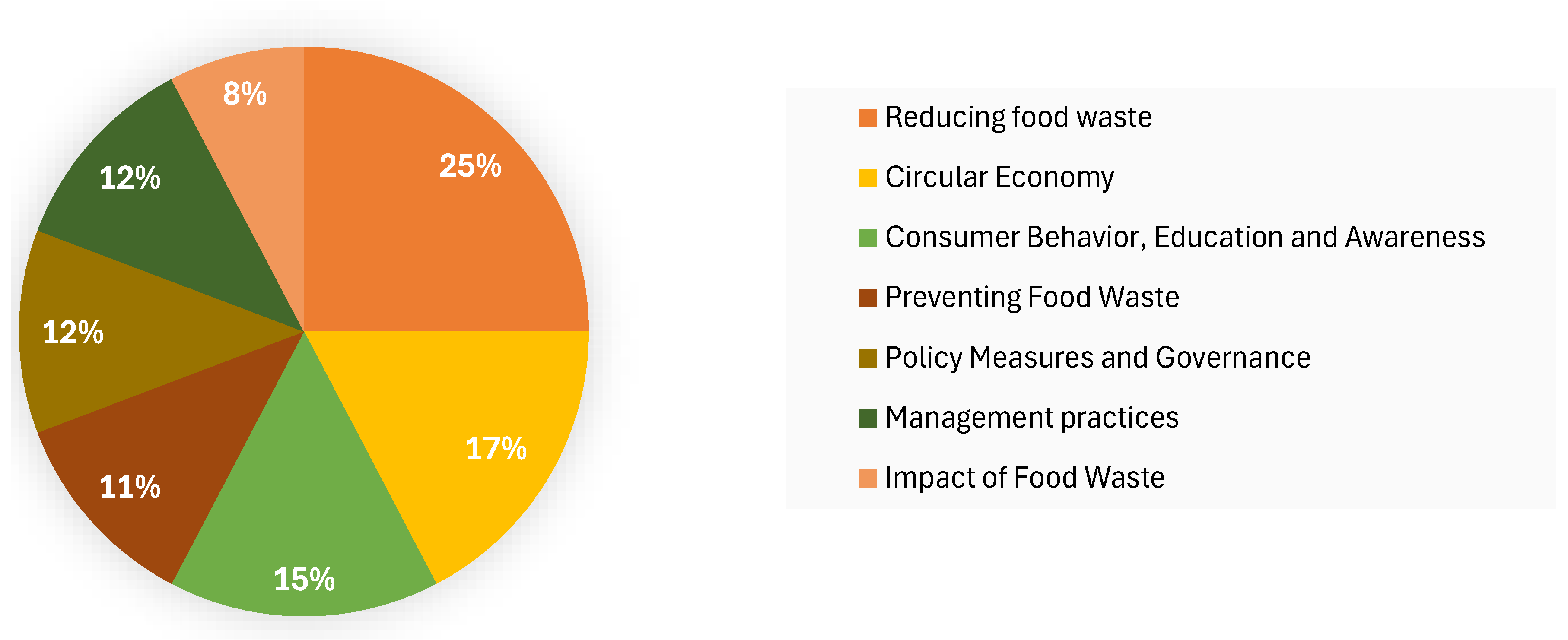The selection of 52 articles for this study on food waste demonstrates a considered approach with thematic diversity that captures the complexity of the subject. Despite the predominant focus on waste mitigation strategies, encompassing a variety of approaches and techniques, a significant portion of the selected articles examines food waste control policies, generally highlighting the crucial influence of governmental decisions. Other equally important articles explore the causes of waste and consumer behavior, providing insights into the factors driving waste, particularly at the final stages of the supply chain. Additionally, studies adopting the circular economy perspective offer a broader view, integrating food waste into sustainable economic models, while emphasizing the need for bold and tailored approaches. This sample of the literature provides a robust and comprehensive foundation for understanding and addressing food waste from multiple perspectives.
3.3. Key Topics and Underlying Principles for an IFWRS
Based on the literature structured around the seven categories outlined in
Figure 10, key topics were identified, and their potential translation into principles for an IFWRS was explored.
Table 2,
Table 3,
Table 4,
Table 5,
Table 6,
Table 7 and
Table 8 summarize these contributions, showcasing the alignment between the identified topics and the foundational principles of the IFWRS. This analysis provides a robust framework to support further discussions and guide the design of integrated and sustainable interventions. The “Food Waste Reduction” category (
Table 2) explores strategies and insights aimed at minimizing waste throughout the food supply chain. It focuses on both the challenges and opportunities associated with reducing food loss and waste, highlighting actionable approaches to drive meaningful improvements.
For example, Irani and Sharif [
7] highlight that traditional strategic planning tools may be insufficient to address the complexity of food security systems. This observation underscores the need for a broader and holistic perspective that transcends conventional planning methodologies. The interdependencies and multifaceted challenges within food security require integrated approaches that consider social, economic, environmental, and technological dimensions. Consequently, this principle advocates for designing strategies that address systems as a whole rather than in isolated components, ensuring more comprehensive and effective solutions. Similar observations are made by Helander et al. [
22], Lekavičius et al. [
23], and Irani and Sharif [
7], who also emphasize the need for integrated strategies.
However, the recognition of structural inefficiencies and the need for adaptive solutions to address food waste has been highlighted by Caldeira et al. [
15], Bunditsakulchai and Liu [
24], and Riesenegger and Hübner [
25]. These studies stress the importance of Guidance for Effective Policies, focusing on data-driven approaches to enhance stock management and demand forecasting, the implementation of context-specific strategies to reduce household waste, and the development of tailored policies to address the complexity of food supply chains. Collectively, these insights emphasize the need for comprehensive, context-aware policies that effectively combat food waste across all stages of the supply chain and within diverse socio-economic settings.
Mesiranta, Närvänen, and Mattila [
26] focus on the accountability and involvement of stakeholders in the political debate surrounding food waste reduction. Their work emphasizes shared responsibility and the need for transdisciplinary collaboration. By engaging diverse stakeholders—including policymakers, industry actors, researchers, and civil society—collaborative efforts can drive innovative, multi-perspective solutions to food waste challenges.
Mattsson and Williams [
27] examine supermarket management practices and policies aimed at reducing fruit and vegetable waste, while Usubiaga et al. [
28] emphasize the accelerated adoption of preventive measures targeting household waste. Together, these insights highlight the importance of consumer education and awareness as a critical principle for food waste reduction. By promoting informed consumer behavior and raising awareness of waste prevention strategies, educational initiatives can bridge the gap between upstream management practices and downstream household actions, fostering more sustainable consumption patterns.
Recognizing and overcoming structural barriers to efficient waste management, as observed by Black et al. [
29], is closely tied to the Guide for Innovation and Technological Implementation. Addressing these barriers often necessitates the adoption of innovative technologies and solutions that improve efficiency, optimize processes, and drive sustainable advancements in waste management systems.
Table 2.
Key topics and underlying principles for an IFWRS: insights from the literature on food waste reduction. Source: created by authors.
Table 2.
Key topics and underlying principles for an IFWRS: insights from the literature on food waste reduction. Source: created by authors.
| Source | Key Topics Description | Related Principle |
|---|
| [4] | Food security management through the analysis and mitigation of food waste and loss | Holistic Approach |
| [8] | Strategic planning tools may be insufficient to address the complexity of the food security system |
| [22] | Need to integrate waste reduction strategies with potential dietary changes |
| [23] | Comprehensive strategies to reduce food waste and mitigate socioeconomic impacts |
| [15] | Complexity of food waste across the EU supply chain and the need for tailored policies | Guidance for Effective Policies |
| [24] | Integrated approaches to minimize household waste in Bangkok |
| [25] | Stock management and demand forecasting as significant causes of waste in ultra-fresh products |
| [30] | Public policies and cross-sectoral collaboration in reducing food loss and waste in Costa Rica | Stimulus for Transdisciplinary Collaboration |
| [26] | Accountability and involvement of stakeholders in the political debate surrounding food waste reduction |
| [28] | Accelerated adoption of preventive measures, particularly targeting household waste | Consumer Education and Awareness |
| [27] | Supermarket management practices and policies for reducing fruit and vegetable waste |
| [29] | Recognizing and overcoming structural barriers to efficient waste management | Guide for Innovation and Technological Implementation |
Similar principles were identified in the “Circular Economy” category (
Table 3), which reflects the integration of circular principles into food systems. This category emphasizes sustainable resource use, the promotion of recycling, and the implementation of innovative strategies to minimize waste and close resource loops. By embedding circular principles, food systems can transition toward greater sustainability, efficiency, and resilience.
Table 3.
Key topics and underlying principles for an IFWRS: insights from the literature on circular economy. Source: created by authors.
Table 3.
Key topics and underlying principles for an IFWRS: insights from the literature on circular economy. Source: created by authors.
| Source | Key Topics Description | Related Principle |
|---|
| [8] | Development of tools addressing food security in circular economy | Holistic Approach |
| [31] | Agroecological practices and healthy diets |
| [16] | Sustainable management of household food waste | Holistic Approach and environmental sustainability in mind. |
| [32] | Potential impacts of the European Union’s circular economy policy on Japanese manufacturers | Stimulus for Transdisciplinary Collaboration |
| [33] | Business models for urban food waste prevention and recycling |
| [34] | Linking food loss, waste, and food security | Guidance for Effective Policies |
| [35] | Sustainable strategies for circular bioeconomy | Guide for Innovation and Technological Implementation |
| [36] | Transition to a circular economy in household food waste practices | Consumer Education and Awareness |
| [37] | Integration of circular economy topics in education |
The “Consumer Behavior, Education, and Awareness” category (
Table 4) underscores the critical role of individual actions, educational initiatives, and consumer practices in addressing food waste. This category emphasizes how informed decision making, behavioral changes, awareness initiatives and effective policies can significantly contribute to reducing food waste at both household and systemic levels.
Table 4.
Key topics and underlying principles for an IFWRS: insights from the literature on consumer behavior, education, and awareness. Source: created by authors.
Table 4.
Key topics and underlying principles for an IFWRS: insights from the literature on consumer behavior, education, and awareness. Source: created by authors.
| Source | Key Topics Description | Related Principle |
|---|
| [17] | Integration of eating habits, waste management, and personal values for public policies | Guidance for Effective Policies |
| [38] | Influence of removing expiration date labels on reducing food waste | Consumer Education and Awareness |
| [39] | Environmental and economic impacts of food waste in university canteens and actions to reduce it |
| [40] | Emotional and cognitive behaviors in reducing household food waste |
| [41] | Psychological motivations and moral norms in sustainable practices |
| [42] | Redistribution model of social supermarkets and the need to understand the factors driving their use |
| [43] | Relationship between motivation and food management practices in preventing waste |
| [44] | Changes in consumer behavior reducing carbon footprints | Holistic Approach |
The “Food Waste Prevention” category (
Table 5) emphasizes the importance of proactive measures, daily routine practices, and systemic approaches aimed at preventing food waste at its source. By tackling waste before it occurs, this category highlights the need for integrated strategies and holistic approaches, including consumer education, effective policies, transdisciplinary collaboration, and innovative technological practices. These strategies collectively promote efficiency, minimize resource loss, and foster the development of sustainable food systems.
Table 5.
Key topics and underlying principles for an IFWRS: insights from the literature on food waste prevention. Source: created by authors.
Table 5.
Key topics and underlying principles for an IFWRS: insights from the literature on food waste prevention. Source: created by authors.
| Source | Key Topics Description | Related Principle |
|---|
| [45] | Sector-specific policies and economic/environmental benefits of waste prevention | Guidance for Effective Policies |
| [18] | Key moments in daily practices leading to waste and effective intervention areas | Consumer Education and Awareness |
| [46] | Operational causes of food waste and the need for efficient policies and management | Stimulus for Transdisciplinary Collaboration |
| [47] | Aligning operational practices with Sustainable Development Goals to reduce waste | Holistic Approach |
| [48] | Environmental footprint and mitigation strategies for vegetable waste in the USA | Guide for Innovation and Technological Implementation |
| [49] | Socioeconomic factors guiding policies for mitigating food loss in poorer countries | Guidance for Effective Policies |
The “Policy Measures and Governance” category (
Table 6) explores the critical role of effective legislation, governance frameworks, and public policies in mitigating food waste. It emphasizes key principles such as guidance for effective policies, a holistic approach, a stimulus for transdisciplinary collaboration, and consumer education and awareness. These elements collectively highlight the importance of well-designed policies, integrated strategies, stakeholder cooperation, and informed consumer behavior in achieving meaningful and sustainable food waste reduction.
Table 6.
Key topics and underlying principles for an IFWRS: insights from the literature on policy measures and governance. Source: created by authors.
Table 6.
Key topics and underlying principles for an IFWRS: insights from the literature on policy measures and governance. Source: created by authors.
| Source | Key Topics Description | Related Principle |
|---|
| [19] | Influence of economy, politics, and lifestyle on resource consumption and the role of policy | Holistic Approach |
| [20] | Improvements in European legislation through economic incentives and regulatory reforms | Guidance for Effective Policies |
| [50] | Evaluation of food losses and waste to inform effective European policies |
| [51] | Comparative analysis of waste management policies and their impact on reducing greenhouse gases |
| [52] | Governance measures for food waste reduction and areas for improvement in Norway | Stimulus for Transdisciplinary Collaboration |
| [53] | Consumer-centered policies adapted to socioeconomic conditions to reduce household food waste | Consumer Education and Awareness |
The “Food Waste Management Practices” category (
Table 7) focuses on transitioning from isolated practices to integrated systems, incorporating sustainable strategies that engage all actors across the food supply chain. It underlines the need for transdisciplinary collaboration, a guide for innovation and technological implementation, and effective policies, all built on a holistic approach and grounded in consumer education and awareness.
Table 7.
Key topics and underlying principles for an IFWRS: insights from the literature on food waste management practices. Source: created by authors.
Table 7.
Key topics and underlying principles for an IFWRS: insights from the literature on food waste management practices. Source: created by authors.
| Source | Key Topics Description | Related Principle |
|---|
| [54] | Innovative treatments for final disposal of food waste, emphasizing efficiency and role of public policies | Guidance for Innovation and Technological Implementation |
| [21] | Conceptual model linking food waste reduction to food poverty alleviation | Holistic Approach |
| [55] | Quantification of energy savings and environmental footprint reduction through food waste reduction |
| [56] | Use of Life Cycle Assessment (LCA) to create policy measures for sustainability and food security | Guidance for Effective Policies |
| [57] | Transition from isolated practices to integrated systems, emphasizing collaboration and behavior change | Stimulus for Transdisciplinary Collaboration |
| [57] | Behavioral aspects influencing waste management practices through perceptions of food security | Consumer Education and Awareness |
The “Impact of Food Waste” category (
Table 8) explores the environmental, economic, and social effects of food waste, along with strategies for its mitigation. To effectively address these impacts, it is essential to have support tools that guide a more innovative and technologically advanced sector, underpinned by effective policies and transdisciplinary collaboration within a holistic approach.
Table 8.
Key topics and underlying principles for an IFWRS: insights from the literature on the impact of food waste. Source: created by authors.
Table 8.
Key topics and underlying principles for an IFWRS: insights from the literature on the impact of food waste. Source: created by authors.
| Source | Key Topics Description | Related Principle |
|---|
| [58] | Double energy waste associated with food waste in Italy | Holistic Approach |
| [6] | Accounting for food waste in European and global supply chains | Guidance for Effective Policies |
| [59] | Decision support tools for transitioning to a circular economy | Guide for Innovation and Technological Implementation |
| [60] | Waste management in the online food delivery industry in China | Stimulus for Transdisciplinary Collaboration |
The bibliometric analysis conducted in this study revealed the key emerging themes related to food waste, which were organized into specific categories based on the most frequently discussed topics in the literature. The categories—food waste management practices, consumer behavior and education, public policies, and technological innovation—reflect various dimensions of the issue and the potential solutions explored in academia over time.
However, analyzing these categories in isolation highlights critical evidence that food waste cannot be effectively addressed from a single perspective. The problem’s dimensions are deeply interconnected, and the analysis revealed that fragmented approaches often yield limited long-term results.
Addressing the multifaceted complexity of food waste requires integrated and innovative approaches that unify diverse perspectives within a holistic framework. This foundation informed the development of the principles for an IFWRS, which aims to provide a comprehensive and adaptable response to the gaps identified in the existing literature and practices.
Reaching this conclusion necessitated a deep reflection on how the categories interact with one another. For instance, while public policies can be impactful, their success is contingent on consumer engagement, as individual behaviors and daily practices play an important role in waste reduction. Similarly, technological innovations, although indispensable, require public policies to incentivize their adoption and consumer education to ensure their effective use. These interdependencies accentuate the need for a cohesive strategy that bridges gaps between isolated approaches.
This process culminated in the formulation of the IFWRS, which proposes principles designed not only to address the root causes of food waste across different sectors but also to interconnect these causes within a cohesive and adaptable strategy. Each principle emerged from the intersection of the identified categories, emphasizing that integrating public policies, consumer behavior, and technological innovation can generate a positive, self-sustaining cycle where progress in one area strengths advancements in others.
The IFWRS principles are grounded in these interconnected elements and the identifies categories, offering a robust framework for practical and effective application across different contexts. The proposal transcends theoretical constructs, aiming to align with global sustainability objectives while being adaptable to the diverse challenges posed by food waste.
